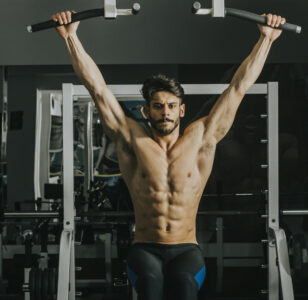Introduction
Dumbbell is one of the standard fitness equipment, which is used widely in gymnasiums and homes. Dumbbell is small fitness equipment and portable. Dumbbell for enhancing muscle strength, muscle complex movement training has a significant function. How much do you know about dumbbells? Let’s start with this blog.
Contents
Basic Knowledge of Dumbbells
Dumbbells are simple equipment used for muscle strength training. The primary material is cast iron. However, some dumbbells are coating with rubber. In addition to iron dumbbells, there are wood dumbbells and plastic (frosted and impregnated) dumbbells.
The benefit of Dumbbell exercises (Dumbbell proper function of each block muscle)
- Lower back: Dumbbells put less pressure on the spine than barbells do. Plus, dumbbells are more comfortable. If you use dumbbells to do straight leg exercises, you can also effectively develop the biceps femoris.
- Leg: Stand and hold dumbbells to raise one leg heel, which is better than a calf machine. You can also step on the board with the front palm of your foot and place the dumbbell on your knee for a one-leg or two-leg sitting heel lift.
- Back: Lean rowing with one or two dumbbells (one-armed rowing is safer for the lower back) builds back muscles faster than a barbell. One-arm dumbbell rowing has been a favorite back exercise for seven-time Mr. Olympia winner Lee Haney. Do dumbbell flexion exercises on the supine bench, train the serratus anterior muscle in the chest and develop the muscle groups on both sides of the back.
- Chest: Bench presses, up and down presses with dumbbells are better for muscle growth than barbells because they stimulate the muscles more broadly and deeply. Also, use dumbbells to do multi-angle bird exercises to develop all parts of the pectoral muscles. An excellent way to do this is to do a bench press exercise immediately after finishing a dumbbell bird. This exercise not only good effect, and it can reduce the shoulder burden, avoid sports injury.
- Shoulders: All forms of dumbbell exercises develop shoulder muscles. For example, use dumbbells to do side raises, front raises, and flying down movements to build the shoulder deltoid muscles’ middle, show, and back bands. In addition, developing the trapezius muscle can be done with dumbbell shrug or loop exercises.
- Biceps: The dumbbell bend is one of the best exercises many champion bodybuilders use to develop biceps peaks. Different dumbbell bends make the upper arms more robust, and the muscle blocks separate and stand out when viewed from behind.
- Triceps: use dumbbells to do single-arm or double-arm neck extension exercises to develop the triceps into a horseshoe shape. You can lower the dumbbell as far as possible to strengthen the training effect.
- Forearm: dumbbell holding wrist bending can develop the medial forearm muscle group; Developing the lateral muscles of the forearm is associated with a reverse grip and bending.
- Thighs: Do dumbbell squat exercises with small boards on the heels to develop quadriceps.
- Abdomen: supine, the dumbbell placed behind the head to sit up, can practice the upper abdominal muscles; Pull in the stomach and lift the legs (the upper body does not move) to exercise the lower abdominal muscles.
Dumbbell Common Mistake
Scientific use of dumbbells can indeed receive excellent exercise results. But many people who use dumbbells neither achieved a fitness effect, did not increase muscle strength and were then disappointed.
Dumbbell fitness has a lot of knowledge. Before learning the science of using dumbbells, let’s understand what the common mistakes are!
Mistake 1. Exercise with a dumbbell can increase strength and bodybuilding body.
- Before conducting dumbbell training, we first need to clarify strength and fitness, which is their goal. There are two main ways to build muscle: Improve the power of the exerciser, but the effect of bodybuilding is not apparent, more suitable for professional weightlifters.
- Increase muscle mass, but with a relatively slight increase in strength, therefore preferred by bodybuilders and mass fitters.
Mistake 2. Dumbbells only exercise the upper limbs.
Dumbbells are great for working the upper limbs working the lower back and abdominal muscles. Such as sit-ups in the back of the neck with both hands clenched dumbbells can increase abdominal strength.
Back flexion and extension exercises can also use dumbbells to raise a load of back muscles to stimulate the growth of back muscles. Holding a dumbbell body side bending or turning movement can exercise the abdominal and external oblique muscles. Having dumbbells straight arm forward lift, side flat lift can exercise shoulder and chest muscles; In addition, dumbbells can also exercise lower limb muscles, such as holding dumbbells squat on one foot, squat jump on both feet and so on.
Mistake 3. Dumbbell is not suitable for seniors.
- Many fitness enthusiasts in the elderly often choose jogging, broadcast gymnastics or Tai Ji, and other strength projects few older adults know; the dumbbell is not considering. It generally believes that strength declines with age, so it is not suitable for strength training. That’s not the case. In a sense, because power has gone down, there’s more need for strength training.
- Muscles move and help the body stay still. However, with the growth of age, muscle fibers naturally atrophy, strength decline, slow movement, and reduced stability. In addition, tendon and periosteum are more prone to excessive wear, so the possibility of pain in each joint is significantly increased. Appropriate strength exercise can not only delay the process of muscle atrophy in the elderly. Maintain muscle elasticity, lay a foundation for better engaging in other forms of fitness activities, and increase the protective effect of muscle on the stability of each joint. Dumbbells are small and exquisite, inexpensive, especially suitable for elderly strength exercise.
Scientific use guide and precautions for dumbbells
- Choose proper weights and frequencies before practicing dumbbells.
Dumbbell training aims to build muscle, the best choice of 65-85% weight dumbbells. For example, each lift is 10kg, should choose 6.5-8.5kg dumbbell training. Dumbbell exercises are performed 5-8 times per day, 6-12 times per set, at a constant speed, 2-3 minutes apart.
- Scientific Use Guide of Dumbbells
First of all, feet apart, shoulder width, chest, and abdomen, maintain stability, upper arm and forearm to maintain a 90-degree angle, hold the dumbbell, palm straight ahead, hands eye relative, and then slowly lift, lift the dumbbell to breathe out. Still, the action must be slow, not too fast. It is best to maintain a uniform speed.
- Precautions
Push the dumbbell when the action is not too fast. If the speed is too fast, coupled with the body swing, it is easy to cause muscle strain; severe will cause muscle tear. In addition, the use of dumbbells in their suitable range, too heavy words will increase the chance of injury. Dumbbell movement on the fixed joint requirements is very high. If the action is too fast or the dumbbell is too heavy, then easy to make the joint injury. Lifting dumbbell action is too fast, tendon stress is more, can exercise a specific explosive power, but the muscle exercise is minimal, is not up to a good fitness effect.
Conclusion
Now that we’ve learned about the benefits of correctly using dumbbells let’s embark on the dumbbell journey to get the perfect muscles!
We would recommend a 5lb (2.5kg) or 10lb (4 or 5kg) as the lightest weight (depends on your strength level, some people are naturally stronger) and then from there pairs of 15lb (8kg), 20lb (10kg), 30lb (14kg), and 40lb (18kg) or 50lb (24kg).
If you are comfortable at the gym and need some guidance, 8-12 lbs is a good range for you. However, if you're advanced, you should be looking to invest in one heavy dumbbell that is 15+ lbs. Then, you'll be able to diversify your workouts with a more serious option.
RELIFE picks of the best dumbbells to use at home
https://relifesports.com/dumbbell-knowledge-introduction/
https://relifesports.com/5-ways-you-can-use-dumbbells-and-benches-to-train-your-whole-body-muscles/
Relife Brand Value Proposition
Relife Official Global Fitness Center
[Relife Rebuild Your Life]To provide fitness enthusiasts with the most professional action guidance and the most complete body and fitness information! Gain muscle and reduce fat; fun information; on the way to fitness; you and I will go together!













